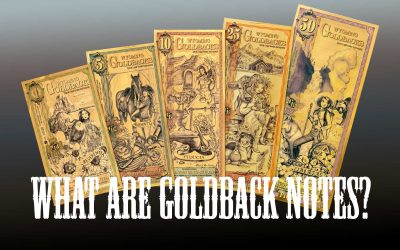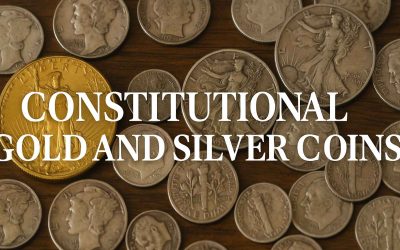As inflation erodes the value of the U.S. dollar and trust in fiat currencies declines, many individuals and communities are seeking alternative means of trade that preserve purchasing power and align with sound money principles. One such innovation is the Goldback®, a voluntary local currency backed by fractional gold that can be used in day-to-day commerce. But to truly engage with this system, it’s important to understand the Goldback Exchange Rate—how it’s determined, how it’s used, and how you can integrate Goldbacks into your daily life or business.
What Is a Goldback?
A Goldback® is a physical form of voluntary currency made with precise amounts of 24-karat gold layered between durable polymer sheets. Each Goldback is a spendable, interchangeable, and non-governmental form of money that can be used for small transactions, even as small as a few cents in value.
Goldbacks come in seven denominations:
- 0.5 Goldback
- 1 Goldback
- 5 Goldbacks
- 10 Goldbacks
- 25 Goldbacks
- 50 Goldbacks
- 100 Goldbacks
Each denomination contains a proportional amount of gold by weight. For example, 1 Goldback contains 1/1000th of a troy ounce of gold, while 50 Goldbacks contain 1/20th of a troy ounce.
Goldbacks are legal to own and spend in every U.S. state, but are officially recognized as legal tender only in states that have passed laws affirming gold and silver as money.
What Is the Goldback Exchange Rate?
The Goldback Exchange Rate is the daily calculated value of 1 Goldback unit in U.S. dollars, based on the cost of acquiring fractional gold, minting the physical Goldback, and ensuring its availability as a currency. Unlike the spot price of gold (which represents bulk, non-fabricated gold), the Goldback rate reflects:
- The cost of physical gold at small denominations
- Minting and fabrication costs
- Availability and market demand
- Logistics and distribution considerations
For example, if the Goldback Exchange Rate is $4.00, that means 1 Goldback is worth $4.00 USD. Thus, a 10 Goldback note would represent $40 in purchasing power.
There are multiple exchange rates used in the ecosystem:
- Goldback Official Exchange Rate– the estimated retail value of a Goldback, published by Goldback and used by most Goldback accepting merchants and in the Goldback Calculator.
- UPMA Exchange Rate – the official exchange rate calculated by the United Precious Metals Association (UPMA), often used by members
- UPMA Buy Back Rate – the rate at which dealers or UPMA will purchase Goldbacks back from customers
UPMA Exchange Rate 1 = $7.92 USD
UPMA Buyback Rate 1 = $7.12 USD
Why the Exchange Rate Is Different from the Spot Price of Gold
Some may wonder why Goldbacks cost more than the equivalent weight of bulk gold. The answer lies in fractionalization and utility.
- Bulk gold (1 oz bars or coins) is cheaper per ounce because it’s easier to manufacture and sell in large quantities.
- Goldbacks are ultrafractional—even smaller than traditional 1/10 oz coins. This fractional nature allows you to spend gold in amounts as low as $1 to $5, which is not feasible with traditional coins or bars.
- This convenience, coupled with production costs and durability features, naturally results in a premium over the spot price.
How to Use the Goldback Exchange Rate
To use Goldbacks in daily transactions, you need to understand how to interpret the exchange rate and apply it correctly:
1. Check the Daily Rate
Start by checking the current exchange rate. You can find the rate through:
- The official Goldback website
- Participating organizations like UPMA
- Independent tracking websites like GoldbackInfo.com
2. Calculate Purchase Price in Goldbacks
To price goods or services in Goldbacks:
- Divide the USD price by the current exchange rate.
Example:
Let’s say today’s Goldback exchange rate is $4.25 USD per Goldback.
A cup of coffee costs $5.00 USD.
$5.00 ÷ $4.25 = 1.18 Goldbacks.
Round to the nearest available denomination or combine with other purchases.
3. Accepting Goldbacks as a Business
If you’re a merchant:
- You can choose to price your items in USD and convert at time of sale, or
- Price items directly in Goldbacks, using the current exchange rate as your baseline.
Make sure to:
- Inform customers of the daily rate
- Offer change in Goldbacks, USD, or both
- Report taxable income in USD per your local regulations
Many merchants also advertise “We Accept Goldbacks” with window decals or signs to promote adoption.
How to Spend Goldbacks in Local Commerce
The Goldback currency is already being used in thousands of businesses across several U.S. states. Here’s how you can use them in everyday transactions:
1. Find Participating Merchants
Use directories like:
- Goldback Merchant Directory
- UPMA Merchant Listings
- Community forums and Facebook groups
Merchants include:
- Coffee shops
- Restaurants
- Farmers markets
- Hair salons
- Auto mechanics
- Gift shops and craft vendors
2. Offer to Pay with Goldbacks
When shopping, ask:
“Do you accept Goldbacks?”
Most merchants who are listed in directories will say yes, but even those unfamiliar might accept them once you explain:
- Each one contains real 24k gold
- They hold intrinsic value
- The exchange rate is verifiable online
- Businesses can resell them or deposit them via UPMA
3. Make the Transaction
Let’s say your lunch bill is $12.00 USD and the Goldback Exchange Rate is $4.00.
$12 ÷ $4 = 3 Goldbacks.
You can pay with:
- 3x 1 Goldback notes
- 1x 2 Goldbacks + 1x 1 Goldback
- 1x 5 Goldback note + 2 Goldbacks in change (or USD in change)
The merchant can give you change in Goldbacks or USD.
Benefits of Using Goldbacks in Local Commerce
- Preserve Value: Goldbacks are inflation-resistant and backed by real gold.
- Promote Local Economy: Keeps money circulating in community-focused systems.
- Alternative to Fiat: Offers a tangible, trusted alternative to central-bank issued currency.
- Encourage Sound Money: Supports education and transition to asset-based currency.
- Beautiful and Durable: Goldbacks are works of art, making them highly recognizable and appreciated.
Practical Considerations
- Taxes: Businesses must still report sales and income in USD.
- Change: Some merchants give change in USD, others in Goldbacks—communication is key.
- Storage: Goldbacks are best stored in protective sleeves, similar to currency collectors’ tools.
- Security: Goldbacks are hard to counterfeit due to complex minting and embedded gold.
The Goldback Exchange Rate is more than just a number—it’s a daily indicator of how a local currency based on real gold can integrate into our everyday lives. By understanding how the exchange rate works and how to use it, individuals and businesses alike can reclaim a measure of financial independence, trust, and resilience in a world dominated by fiat currencies.
Whether you’re spending a few Goldbacks at a coffee shop, building local loyalty, or promoting the Sound Money Movement, every transaction helps demonstrate that asset-backed currencies aren’t just for vaults—they’re for life.
Disclaimer: Royal Leo Holdings, LLC and GoldbackInfo.com are not registered financial advisors. All content on this site is provided for informational and educational purposes only and represents our own opinions—not financial advice. You should consult a qualified professional before making any investment decisions.







Hi,
As a UPMA member, I’m trying to understand why the Goldback buyback rate is at a 12.5% premium for a product that has already had premiums applied? I have been stacking since I have very few merchants in the Northern Virginia area that will take GB as payment, let alone for an essential service or product. If the Gold to Silver ratio drops as silver is revalued, I may very well want to exchange for silver dollars or cash out. 1/8 of value seems quite excessive given this is not a sole source of revenue for any of these dealers.